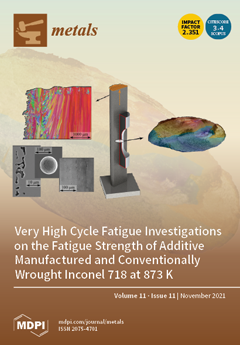The microstructure, isothermal oxidation, and hardness of the Nb-23Ti-5Si-5Al-5Hf-5V-2Cr-2Sn alloy and the hardness and Young’s moduli of elasticity of its Nb
ss and Nb
5Si
3 were studied. The alloy was selected using the niobium intermetallic composite elaboration (NICE) alloy design methodology.
[...] Read more.
The microstructure, isothermal oxidation, and hardness of the Nb-23Ti-5Si-5Al-5Hf-5V-2Cr-2Sn alloy and the hardness and Young’s moduli of elasticity of its Nb
ss and Nb
5Si
3 were studied. The alloy was selected using the niobium intermetallic composite elaboration (NICE) alloy design methodology. There was macrosegregation of Ti and Si in the cast alloy. The Nb
ss, αNb
5Si
3, γNb
5Si
3, and HfO
2 phases were present in the as-cast or heat-treated alloy plus TiN in the near-the-surface areas of the latter. The vol.% of Nb
ss was about 80%. There were Ti- and Ti-and-Hf-rich areas in the solid solution and the 5-3 silicide, respectively, and there was a lamellar microstructure of these two phases. The V partitioned to the Nb
ss, where the solubilities of Al, Cr, Hf, and V increased with increasing Ti concentration. At 700, 800, and 900 °C, the alloy did not suffer from catastrophic pest oxidation; it followed parabolic oxidation kinetics in the former two temperatures and linear oxidation kinetics in the latter, where its mass change was the lowest compared with other Sn-containing alloys. An Sn-rich layer formed in the interface between the scale and the substrate, which consisted of the Nb
3Sn and Nb
6Sn
5 compounds at 900 °C. The latter compound was not contaminated with oxygen. Both the Nb
ss and Nb
5Si
3 were contaminated with oxygen, with the former contaminated more severely than the latter. The bulk of the alloy was also contaminated with oxygen. The alloying of the Nb
ss with Sn increased its elastic modulus compared with Sn-free solid solutions. The hardness of the alloy, its Nb
ss, and its specific room temperature strength compared favourably with many refractory metal-complex-concentrated alloys (RCCAs). The agreement of the predictions of NICE with the experimental results was satisfactory.
Full article





